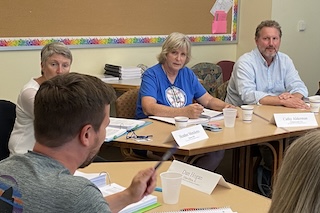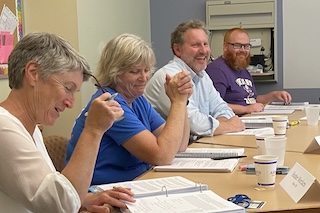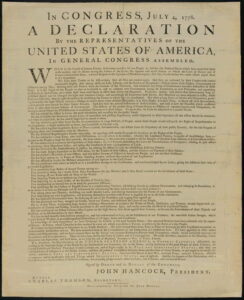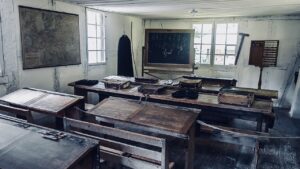
Joshua Dunn, Teachers Discuss Judiciary’s Involvement in Education
Good teachers respond to the needs of the students they seek to educate. Yet in their approach to this task, they are also responsible to administrators, parents, school boards—and, increasingly, to state and federal courts. Since the middle of the twentieth century, “seemingly no aspect of education policy has been too insignificant to escape judicial oversight,” writes Professor Joshua Dunn, in a 2008 essay he coauthored with Martin R. West, “The Supreme Court as School Board Revisited.” Little wonder that Dunn’s course in this year’s summer residential Master of Arts in American History and Government (MAHG) program, “From Courthouse to Schoolhouse,” drew teachers from urban and rural areas across the country. All wanted to better understand the court’s jurisprudence on education issues, including school financing; students,’ parents’ and teachers’ rights; and local citizens’ oversight of the education offered in their communities. “The course covers the history of the judiciary’s involvement in education, helping us better understand policies followed today,” said a teacher in the course. “But it also covers issues that are still being litigated.”
The Impact and Limits of Judicial Power
The earliest case teachers discussed in the course—Plessy v. Ferguson (1896)—established the precedent of racially “separate but equal” public accommodations that was overturned in Brown v. Board of Education (1954), probably the most consequential Supreme Court ruling on education to date. After discussing Brown, teachers went on to discuss later, related cases. These ruled on the constitutionality of a number of complicated desegregation plans devised for large urban areas with segregated housing patterns. Professor Dunn’s first book, Complex Justice (2008), examines the 1995 case of Missouri v. Jenkins, in which the court found that a desegregation plan devised for Kansas City by a federal district court did little to improve the quality of education in the district and the racial isolation of the students despite spending over $2 billion. In the end, a coalition of black parents led an effort to take over the school board and end judicial supervision.

As the above examples suggest, to study the court’s jurisprudence on education issues is to trace several threads in the country’s ongoing conversation over how best to achieve our national ideals of liberty and equality. But it is also to explore the limits of judicial power to achieve these ideals. To some extent, courts are equipped to rule on the intent behind educational policy—whether that intent accords with Constitutional guarantees of citizens’ rights. But they are not well equipped to judge which policies will best achieve the educational outcomes that one hopes would result from good intentions. As a result, court rulings on educational policy and practice may seem, to the public eye, to swing from one extreme to another, sometimes, for example, upholding school busing to achieve racial integration and sometimes forbidding it. This happens because the public tends to focus on the hated expedient—busing—to achieve an end such as equal education for all, instead of focusing on the desired outcome, which is hard even for educational experts to guarantee or measure.
First Amendment Freedoms in Schools
Another set of recent cases the course examined involved the First Amendment guarantees of freedom of speech and religion. This was the theme of the most recent cases the teachers read. Mahanoy v. B.L., decided in 2021, upheld a student’s right to free speech outside of school hours and off of the school campus. Two cases, both decided in June 2022, concerned religious establishment and free religious expression in the educational context. In Carson v. Makin, the majority ruled that a state-funded tuition voucher program in Maine could be used to finance children’s education in religious schools without violating the Establishment Clause and that refusing to do so while funding vouchers for nonreligious schools violated the Free Exercise Clause. In Kennedy v. Bremerton the majority ruled that the firing of a football coach who led players in voluntary prayer on the football field following games violated the coach’s right to free religious expression.
Several earlier cases covered in the course involving First Amendment freedoms might seem, to the casual observer, to have upheld opposite perspectives. Earlier cases involving religious establishment took positions unfavorable to educational policies influenced by the religious motives of the policymakers. These included Epperson v. Arkansas (1968), which overturned an Arkansas state law prohibiting the teaching of human evolutionary theory, and Edwards v. Aguillard (1987), which invalidated a later Louisiana state law requiring that the teaching of human evolutionary theory be accompanied by instruction in the theory of “creation science.” In these cases, the court reasoned that the laws were made to propagate the lawmakers’ religious agendas. A case bearing on students’ free speech rights, Bethel v. Fraser (1986), upheld the suspension of a student who used vulgar and offensive language in a speech he made at a school assembly. But in this case, the critical fact was that the student used offensive language on school property and during a school-sponsored event. The court reasoned that it is proper for schools to uphold standards of civil speech during school activities. Teaching students to use civil speech is part of the public schools’ overall mission to teach responsible citizenship.
Lively But Respectful Discussions
Dunn asked each teacher enrolled in the course to “brief” two of the cases covered in the course. For each briefing, teachers prepared a two-page summary explaining the historical background of the case; lower court rulings on it; the arguments presented when the case reached the Supreme Court; the legal question central to the case; and the court’s decision, along with the reasoning in the majority, concurring, and dissenting opinions. Teachers proved themselves adept at locating justices’ most incisive and telling commentary. Then they opened the class discussion of the case, asking questions that related the case to others they had discussed.
Lively but respectful discussions occurred when teachers from different parts of the country with differing cultural expectations disagreed on the soundness of the majority opinions. For example, a teacher from New Jersey briefed a case involving books removed from school libraries, Board of Education, Island Trees Union Free School District v. Pico (1982). In its opinion, the court ruled that a school board could not ban books it deemed offensive from school libraries.

One teacher from Utah wondered whether, instead of speaking of “banned” books, one should speak of “curated collections” of books. Was it not the school’s responsibility to decide which books were of greatest educational value? If students wanted to read books outside this collection, they might find them in the local public library. The teacher from New Jersey objected to this view, arguing that in the case of students with limited transportation options, school libraries provided their only access to books that fell outside of the school culture’s norms. Other teachers wondered if it depended on the nature of the material found offensive. Did a book deemed objectionable contain gratuitous sex or violence? Or did it simply depict social problems that some find it uncomfortable to consider?
Conflicting Opinions, Yet Far-reaching Consequences
Despite the limits of judicial power to achieve desired results, the teachers in the course concluded that the judiciary’s involvement in education has far-reaching consequences. This occurs even when the Court’s decisions in a given era appear inconsistent. Confusion over the court’s actual position can lead to “defensive teaching,” or the avoidance of topics and reading selections that could provoke parental disapproval and possibly lead to legal challenges. Teachers afraid of this may steer an unnecessarily wide path around painful history that needs to be discussed. Examining cases involving teacher dismissals helped clarify the issues that teachers taking the course really needed to worry about.
Several government teachers looked forward to sharing with their students what they were learning about landmark court cases involving education. A teacher from Arizona planned to ask students in his government class to analyze and discuss the justices’ often conflicting opinions. He felt he could encourage lively but respectful discussions like those in the MAHG class, “if we stick to the constitutional issues.”



